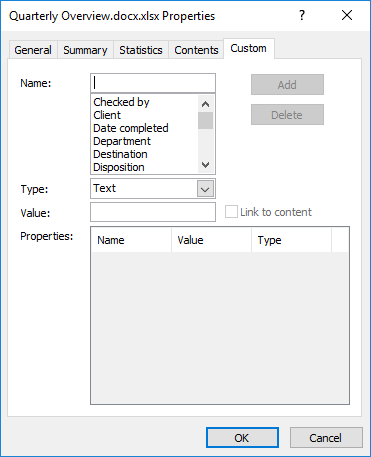Please Note: This article is written for users of the following Microsoft Word versions: 2007, 2010, 2013, 2016, 2019, and Word in Microsoft 365. If you are using an earlier version (Word 2003 or earlier), this tip may not work for you. For a version of this tip written specifically for earlier versions of Word, click here: Creating Custom Document Properties.
Written by Allen Wyatt (last updated July 20, 2019)
This tip applies to Word 2007, 2010, 2013, 2016, 2019, and Word in Microsoft 365
Besides your actual document, Word also maintains quite a bit of statistical and overview information about your document. You can view a portion of this information by choosing the Properties option from the File menu. Word then displays the Properties dialog box for your document, and you can use the different tabs to view the information maintained.
In addition to the standard properties maintained by Word, you can create your own custom document properties. These can then be used within your document (using the DOCPROPERTY field) or within macros. To create a custom document property, start by displaying the Properties dialog box for the document. How you do this depends on the version of Word you are using. If you are using Word 2010 or a later version, follow these steps:
If you are using Word 2007, follow these steps:
Regardless of which version of Word you are using, make sure the Custom tab is selected. (See Figure 1.)

Figure 1. The Custom tab of the Properties dialog box.
From this point you can follow these steps:
WordTips is your source for cost-effective Microsoft Word training. (Microsoft Word is the most popular word processing software in the world.) This tip (12599) applies to Microsoft Word 2007, 2010, 2013, 2016, 2019, and Word in Microsoft 365. You can find a version of this tip for the older menu interface of Word here: Creating Custom Document Properties.

The First and Last Word on Word! Bestselling For Dummies author Dan Gookin puts his usual fun and friendly candor back to work to show you how to navigate Word 2013. Spend more time working and less time trying to figure it all out! Check out Word 2013 For Dummies today!
Word maintains, in a document's properties, several dates such as the date the document was created and last accessed. ...
Discover MoreWord keeps track of quite a bit of document-related information that it refers to as "properties." Here's how to control ...
Discover MoreWord maintains a collection of descriptive properties for each document you create. One of these properties is the Title ...
Discover MoreFREE SERVICE: Get tips like this every week in WordTips, a free productivity newsletter. Enter your address and click "Subscribe."
2019-07-22 13:57:01
Gene Osten
Is it possible to have a Custom Property included on the "Properties" list (displayed when clicking on "File")?
Got a version of Word that uses the ribbon interface (Word 2007 or later)? This site is for you! If you use an earlier version of Word, visit our WordTips site focusing on the menu interface.
Visit the WordTips channel on YouTube
FREE SERVICE: Get tips like this every week in WordTips, a free productivity newsletter. Enter your address and click "Subscribe."
Copyright © 2024 Sharon Parq Associates, Inc.
Comments